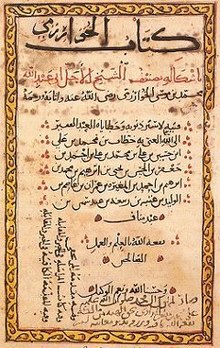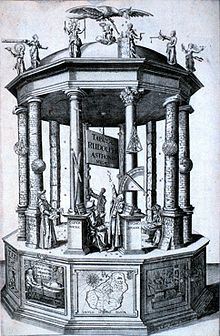用戶:Xreedl/Sandbox1

| 科學史 |
|---|
 |
|
數學起源於人類早期的生產活動,為古中國六藝之一,亦被古希臘學者視為哲學之起點。數學的希臘語μαθηματικός (mathematikós)意思是「學問的基礎」,源於μάθημα (máthema)(「科學,知識,學問」)。
數學最早用於人們計數、天文、度量甚至是貿易的需要。這些需要可以簡單地被概括為數學對結構、空間以及時間的研究。
對結構的研究是從數字開始的,首先是從我們稱之為初等代數的——自然數和整數以及它們的算術關係式開始的。更深層次的研究是數論。
對空間的研究則是從幾何學開始的,首先是歐幾里得幾何和類似於三維空間(也適用於多或少維)的三角學。後來產生了非歐幾里得幾何,在相對論中扮演着重要角色。
到了16世紀,算術、初等代數及三角學等初等數學已大體完備。17世紀變數概念的產生使人們開始研究變化中的量與量的互相關係和圖形間的互相變換。隨着自然科學和技術的進一步發展,為研究數學基礎而產生的集合論和數理邏輯等也開始慢慢發展。
數學史研究主要專注於諸多數學發現和理論的起源,其次是過去的數學方法和標記法。
近代以前,人類知識尚未能在全球範圍內自由傳播,數學領域的新發現只能在小範圍內靠紙筆相傳。現在還存世的最早的數學文本是Plimpton 322(巴比倫數學,公元前1900年),[1]萊因德數學紙草書(埃及數學,公元前2000-1800年)[2] 和莫斯科數學紙草書 (古埃及數學,公元前1890年)。所有這些文本的內容都與勾股定理相關——它幾乎是基礎算術和幾何的框架形成之後最古老和最廣為人知的數學發現。
古希臘數學為數學方法的改善和精煉做出了巨大貢獻,不僅在演繹推理的引進和數學證明的嚴謹性提高上,還擴展了數學研究對象的範圍。[3] 數學研究作為一個獨立的學科開始出現是在公元前六世紀,其歸功於畢達哥拉斯學派:他們根據古希臘語μάθημα(mathema)創造了術語「mathematics」,意思是「學科之基礎」("subject of instruction")。[4] Chinese mathematics made early contributions, including a place value system.[5][6] The Hindu-Arabic numeral system and the rules for the use of its operations, in use throughout the world today, likely evolved over the course of the first millennium AD in India and was transmitted to the west via Islamic mathematics.[7][8] Islamic mathematics, in turn, developed and expanded the mathematics known to these civilizations.[9] Many Greek and Arabic texts on mathematics were then translated into Latin, which led to further development of mathematics in medieval Europe.
From ancient times through the 中世紀, bursts of mathematical creativity were often followed by centuries of stagnation. 從16世紀的意大利文藝復興時期開始,new mathematical developments, interacting with new scientific discoveries, were made at an increasing pace that continues through the present day.
史前數學[編輯]
古代近東[編輯]
兩河流域[編輯]
埃及[編輯]
古希臘[編輯]
中國[編輯]
印度[編輯]
伊斯蘭世界[編輯]
中世紀歐洲[編輯]
中世紀早期[編輯]
復興[編輯]
早期現代歐洲數學[編輯]
十七世紀[編輯]
十八世紀[編輯]
十九世紀[編輯]
二十世紀[編輯]
二十一世紀[編輯]
數學的未來[編輯]
參見[編輯]
參考文獻[編輯]
延伸閱讀[編輯]
外部連結[編輯]
期刊[編輯]
索引[編輯]
算數代數時代[編輯]
幾何時代[編輯]
函數分析時代[編輯]
微積分時代[編輯]
微積分時代的開始,代表人類的數學進入了新的紀元,這是人類歷史上化時代的進步。 數學研究方向產生歷史:
相關條目[編輯]
外部連結[編輯]
- (中文)數學史--Episte Math
- ^ J. Friberg, "Methods and traditions of Babylonian mathematics. Plimpton 322, Pythagorean triples, and the Babylonian triangle parameter equations", Historia Mathematica, 8, 1981, pp. 277—318.
- ^ Neugebauer, Otto. The Exact Sciences in Antiquity 2. Dover Publications. 1969 [1957]. ISBN 978-048622332-2. Chap. IV "Egyptian Mathematics and Astronomy", pp. 71–96.
- ^ Sir Thomas L. Heath, A Manual of Greek Mathematics, Dover, 1963, p. 1: "In the case of mathematics, it is the Greek contribution which it is most essential to know, for it was the Greeks who first made mathematics a science."
- ^ Heath. A Manual of Greek Mathematics. : 5.
- ^ George Gheverghese Joseph, The Crest of the Peacock: Non-European Roots of Mathematics,Penguin Books, London, 1991, pp.140—148
- ^ Georges Ifrah, Universalgeschichte der Zahlen, Campus, Frankfurt/New York, 1986, pp.428—437
- ^ Robert Kaplan, "The Nothing That Is: A Natural History of Zero", Allen Lane/The Penguin Press, London, 1999
- ^ "The ingenious method of expressing every possible number using a set of ten symbols (each symbol having a place value and an absolute value) emerged in India. The idea seems so simple nowadays that its significance and profound importance is no longer appreciated. Its simplicity lies in the way it facilitated calculation and placed arithmetic foremost amongst useful inventions. the importance of this invention is more readily appreciated when one considers that it was beyond the two greatest men of Antiquity, Archimedes and Apollonius." - Pierre Simon Laplace http://www -history.mcs.st -and.ac.uk/HistTopics/Indian_numerals.html
- ^ A.P. Juschkewitsch, "Geschichte der Mathematik im Mittelalter", Teubner, Leipzig, 1964



